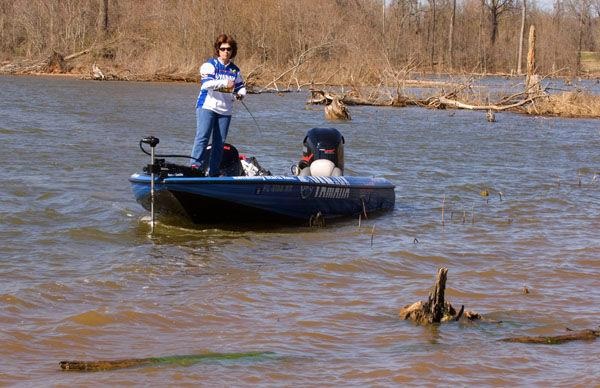Wind may be the great equalizer in bass fishing, but for Yamaha pro Mary DiVicenti, a regular competitor on the Women’s Bassmaster® Tour, wind can also be an advantage.

“Wind-blown shorelines and points can produce fast action because of how the wind and wave action move baitfish around,” DiVicenti explains, “and the longer the wind blows, the better a shoreline can become.
“It’s not that the waves actually wash the baitfish against the shoreline,” she continues, “but rather, that the waves wash plankton to the shore. The waves create a process known as upwelling that brings the plankton to the surface where it then gets washed to a shoreline.
“Shad and other baitfish follow this food source, and the bass follow them. Everything collects against a shoreline, but because everything is still moving and being washed around them, the bass naturally become more active, making it a perfect time and place to fish.”
DiVicenti prefers fishing both spinnerbaits and crankbaits in these conditions, and she frequently alternates lures until bass tell her which one they really want. Initially, the Yamaha pro makes her casts parallel to the bank and as shallow as she can; then, depending on how bass respond, she gradually moves deeper.
“I really like to target any type of cover that may be present, since bass will often use it to ambush prey as it moves by them,” she says. “Medium diving crankbaits that still dig up the bottom can be especially productive, but if there’s a lot of wood cover, I’ll probably change to a double willow leaf spinnerbait because it will come through that wood easier.”
If this presentation does not produce any results, DiVicenti starts casting into the wind and retrieving with the waves. Because these types of casts are more difficult with a spinnerbait, she normally changes to a deeper diving crankbait. Her line choice is 10 or 12-lb. fluorocarbon because of its strength and abrasion resistance.
“Practically any shoreline or point that has waves washing into it can be productive this way,” continues the Yamaha angler, “but I really like rocky shorelines near large flats and coves because the waves will also stir up crawfish, too, which makes my crankbaits even more appealing.
“Steep bluffs and cliffs out in open water can also be good places to fish, as can river points and riprap breakwaters around marinas. In truth, anything the wind hits that stops the movement of water has the potential to hold bass.”
DiVicenti also cautions that while wind-blown areas like this can produce fast fishing action, bass may quickly move away from them when waters calm again.
“They don’t go far,” she says, “but you’ll certainly know when they have moved because you won’t catch anything. Just start fishing a little deeper and perhaps with a bottom-hugging lure like a jig or Carolina rig, and you may re-locate them.”
